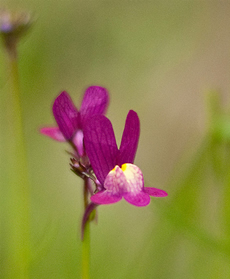Agriculture
Hybrids are offspring of parents from different species. Hybrid zones are areas where such different species overlap and crossbreed. Hybridization and hybrid zones have played a major role in the formation of new species in a number of plant groups and represent major factors in the evolutionary process.
A hybrid individual is produced from successful matings (cross-pollination) between individuals from different species or between individuals from different populations that differ markedly in one or more heritable traits. The mating process by which hybrid offspring are produced is hybridization. A distinction needs to be made between natural and artificial hybrids.
An artificial hybrid typically involves direct human intervention in an effort to obtain plants with agricultural or horticultural properties superior to those of either parent. Natural hybrids do not involve human intervention; they occur naturally.
In many cases hybridization between individuals that belong to different species is prevented by barriers or impediments to cross-pollination, known as reproductive isolating mechanisms.
These mechanisms can be either prezygotic, preventing the formation of hybrid zygotes, or postzygotic, preventing or greatly reducing gamete exchange after a hybrid zygote has been formed.
Hybridization typically occurs between species in which reproductive barriers (such as impediments to crosspollination between members of different species) are not fully formed or are incomplete.
A hybrid zone is a geographic location in which two or more populations of individuals that differ in one or more heritable traits (either of the same or of different species) overlap, cross-breed, and produce viable and sometimes fertile offspring.
The formation of hybrid zones involves sympatric species, that is, species whose geographic ranges overlap. Typically, allopatric species (those whose geographic ranges do not overlap) do not form hybrid zones unless some event, such as wind dispersal of seeds, brings individuals of the two species together.
 Hybridzones can be either continuous zones or a mosaic of scattered groups across a geographic range. They can also differ markedly in size.
Hybridzones can be either continuous zones or a mosaic of scattered groups across a geographic range. They can also differ markedly in size.
For example, the common herb Gaillardia pulchella (Asteraceae family) forms narrow hybrid zones in Texas, where transition progeny formed with neighboring Gaillardia species occurs over a few meters. In contrast, individuals found in hybrid zones involving the Bishop pine, Pinus muricata, in California can be several kilometers wide.
In many cases hybrid zones are the result of human disturbance of the natural landscape. Such disturbance can lead to unique and novel habitat conditions in which the hybrid species might have a selective advantage over the parental species. One example occurs in Washington and Idaho, where certain hybrid zones are incubators for the speciation of Tragopogon mirus and T. miscellus.
Speciation Dynamics of Hybrid Zones
If natural selection eliminates hybrid offspring in the hybrid zone, then the reproductive barriers present in the parental specieswill be reinforced. If, however, the environment within the hybrid zone allows for persistence and reproduction of hybrid taxa, then these hybrids can persist through time, with several possible results.
One result is the eventual establishment of reproductive barriers between the hybrid offspring and the parental species, with the formation of a new species from the hybrid lineage.
In some hybrid zones allopolyploidy can lead to the formation of a sterile hybrid. This occurs when two chromosome sets from different parents are present within one hybrid individual. The sterility is due to irregularities at meiosis, as there is only one chromosome of each type leading to irregular segregation at meiosis.
However, if the chromosome set is doubled through autopolyploidy, meiotic regularity is restored because each chromosome then has a homolog, which allows for successful chromosome segregation and gamete formation. Because of the difference in chromosome number between the polyploid hybrid derivative and the parental species, a reproductive barrier is established, and a new species will be established.
This is the case with two species of goat?s beard, Tragopogon mirus and T. miscellus, from south eastern Washington and adjacent Idaho. The progenitors of the polyploid T. mirus are the diploid species T. dubius and T. porrifolius, and of the polyploid T. miscellus are T. dubius and the diploid T. pratensis.
Another mechanism responsible for the formation of specieswithin a hybrid zone is recombination speciation. In this process the parental genomes present within the semisterile hybrid offspring undergo rearrangement and recombination events over several generations, eventually producing mixed genomes in hybrid individuals.
Over time, fertility is restored in the hybrid individuals, which are then reproductively isolated from the parental species. A prime example of recombination speciation occurs within a group of sunflowers found in the western United States. Helianthus anomalus arose as a consequence of hybridization between two sympatric parental species, H. annuus and H. petiolaris.
Because of genome incompatibilities, the immediate hybrid offspring were reproductively isolated from either parental species and were semisterile. The genome arrangements that occurred over timewithin hybrids and their offspring resulted in increased fertility within the hybrid individual and breeding incompatibility between the hybrids and either parental species.
Introgression and Hybrid Swarms
Introgression occurs when the hybrid offspring engage in backcrossingwith either one or both of the parental species. A hybrid swarm is usually a complex mixture of parental forms, F1 hybrids, and backcross individuals.
The Louisiana irises provide a striking example of an introgressive swarm. Two parental species, Iris fulva and I. hexagona, have produced numerous hybrid populations in southern Louisiana.
The hybrid individuals found in the hybrid zones are not true F1 hybrids but are the progeny resulting from numerous backcrosses to the parental species. A mixture of phenotypes is present in the hybrid swarm, with differing levels of similarity to the parental species among hybrid offspring.
- Gene Flow
Gene FlowGene flow represents a recurrent exchange of genes between populations. This exchange results when immigrants from one population interbreed with members of another. Charles Darwin published On the Origin of Species by Means of Natural Selection...
- Hybridization
HybridizationHybridization is the process of crossing two genetically different individuals to result in a third individual with a different, often preferred, set of traits. Plants of the same species cross easily and produce fertile progeny. Wide crosses...
- Species And Speciation
A species is any group of organisms recognized as distinct, with members able to interbreed with one another and produce fertile offspring. Speciation is the evolutionary process whereby a species comes into existence. Species are distinct kinds of organisms,...
- It Skips A Generation
Long before they understood why the strategy worked, farmers knew how to crossbreed plants to obtain more desirable traits. Even today, a farmer who knows nothing about genetics can tell you that when a blue type of corn crosses with a yellow one, the...
- Development Of Hybrid Rice In India
During the last few years in tropical, hybrid rice technology, India, Vietnam, Philippines, Bangladesh and Indonesia entered the commercialization phase. Research to develop hybrid rice in the 1970s had started in India way back, but with no success....
Agriculture
Hybrid Zones
 |
| Hybrid Zones |
A hybrid individual is produced from successful matings (cross-pollination) between individuals from different species or between individuals from different populations that differ markedly in one or more heritable traits. The mating process by which hybrid offspring are produced is hybridization. A distinction needs to be made between natural and artificial hybrids.
An artificial hybrid typically involves direct human intervention in an effort to obtain plants with agricultural or horticultural properties superior to those of either parent. Natural hybrids do not involve human intervention; they occur naturally.
In many cases hybridization between individuals that belong to different species is prevented by barriers or impediments to cross-pollination, known as reproductive isolating mechanisms.
These mechanisms can be either prezygotic, preventing the formation of hybrid zygotes, or postzygotic, preventing or greatly reducing gamete exchange after a hybrid zygote has been formed.
Hybridization typically occurs between species in which reproductive barriers (such as impediments to crosspollination between members of different species) are not fully formed or are incomplete.
 |
 |
A hybrid zone is a geographic location in which two or more populations of individuals that differ in one or more heritable traits (either of the same or of different species) overlap, cross-breed, and produce viable and sometimes fertile offspring.
The formation of hybrid zones involves sympatric species, that is, species whose geographic ranges overlap. Typically, allopatric species (those whose geographic ranges do not overlap) do not form hybrid zones unless some event, such as wind dispersal of seeds, brings individuals of the two species together.

For example, the common herb Gaillardia pulchella (Asteraceae family) forms narrow hybrid zones in Texas, where transition progeny formed with neighboring Gaillardia species occurs over a few meters. In contrast, individuals found in hybrid zones involving the Bishop pine, Pinus muricata, in California can be several kilometers wide.
In many cases hybrid zones are the result of human disturbance of the natural landscape. Such disturbance can lead to unique and novel habitat conditions in which the hybrid species might have a selective advantage over the parental species. One example occurs in Washington and Idaho, where certain hybrid zones are incubators for the speciation of Tragopogon mirus and T. miscellus.
Speciation Dynamics of Hybrid Zones
If natural selection eliminates hybrid offspring in the hybrid zone, then the reproductive barriers present in the parental specieswill be reinforced. If, however, the environment within the hybrid zone allows for persistence and reproduction of hybrid taxa, then these hybrids can persist through time, with several possible results.
One result is the eventual establishment of reproductive barriers between the hybrid offspring and the parental species, with the formation of a new species from the hybrid lineage.
In some hybrid zones allopolyploidy can lead to the formation of a sterile hybrid. This occurs when two chromosome sets from different parents are present within one hybrid individual. The sterility is due to irregularities at meiosis, as there is only one chromosome of each type leading to irregular segregation at meiosis.
 |
| Speciation Dynamics of Hybrid Zones |
This is the case with two species of goat?s beard, Tragopogon mirus and T. miscellus, from south eastern Washington and adjacent Idaho. The progenitors of the polyploid T. mirus are the diploid species T. dubius and T. porrifolius, and of the polyploid T. miscellus are T. dubius and the diploid T. pratensis.
Another mechanism responsible for the formation of specieswithin a hybrid zone is recombination speciation. In this process the parental genomes present within the semisterile hybrid offspring undergo rearrangement and recombination events over several generations, eventually producing mixed genomes in hybrid individuals.
Over time, fertility is restored in the hybrid individuals, which are then reproductively isolated from the parental species. A prime example of recombination speciation occurs within a group of sunflowers found in the western United States. Helianthus anomalus arose as a consequence of hybridization between two sympatric parental species, H. annuus and H. petiolaris.
Because of genome incompatibilities, the immediate hybrid offspring were reproductively isolated from either parental species and were semisterile. The genome arrangements that occurred over timewithin hybrids and their offspring resulted in increased fertility within the hybrid individual and breeding incompatibility between the hybrids and either parental species.
Introgression and Hybrid Swarms
Introgression occurs when the hybrid offspring engage in backcrossingwith either one or both of the parental species. A hybrid swarm is usually a complex mixture of parental forms, F1 hybrids, and backcross individuals.
The Louisiana irises provide a striking example of an introgressive swarm. Two parental species, Iris fulva and I. hexagona, have produced numerous hybrid populations in southern Louisiana.
The hybrid individuals found in the hybrid zones are not true F1 hybrids but are the progeny resulting from numerous backcrosses to the parental species. A mixture of phenotypes is present in the hybrid swarm, with differing levels of similarity to the parental species among hybrid offspring.
- Gene Flow
Gene FlowGene flow represents a recurrent exchange of genes between populations. This exchange results when immigrants from one population interbreed with members of another. Charles Darwin published On the Origin of Species by Means of Natural Selection...
- Hybridization
HybridizationHybridization is the process of crossing two genetically different individuals to result in a third individual with a different, often preferred, set of traits. Plants of the same species cross easily and produce fertile progeny. Wide crosses...
- Species And Speciation
A species is any group of organisms recognized as distinct, with members able to interbreed with one another and produce fertile offspring. Speciation is the evolutionary process whereby a species comes into existence. Species are distinct kinds of organisms,...
- It Skips A Generation
Long before they understood why the strategy worked, farmers knew how to crossbreed plants to obtain more desirable traits. Even today, a farmer who knows nothing about genetics can tell you that when a blue type of corn crosses with a yellow one, the...
- Development Of Hybrid Rice In India
During the last few years in tropical, hybrid rice technology, India, Vietnam, Philippines, Bangladesh and Indonesia entered the commercialization phase. Research to develop hybrid rice in the 1970s had started in India way back, but with no success....


